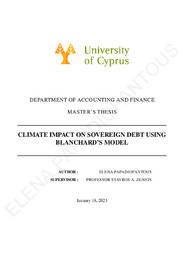Climate impact on sovereign debt using Blanchard’s model

View/
Date
2022-12Author
Papadiofantous, ElenaPublisher
Πανεπιστήμιο Κύπρου, Σχολή Οικονομικών Επιστημών και Διοίκησης / University of Cyprus, Faculty of Economics and ManagementPlace of publication
CyprusGoogle Scholar check
Keyword(s):
Metadata
Show full item recordAbstract
Climate change is without a doubt a subject of great concern and the connection between sovereign debt and climate vulnerability is clear. The purpose of this study is to demonstrate the effect of climate change on the sovereign debt of two European countries, Italy and Netherlands. The Netherlands is an example of a low-debt country, while Italy represents a high-debt country. The purpose of this thesis is twin-fold. In the first part of this thesis, the study is focused on Debt Sustainability Analysis. I employ a simple tochastic debt sustainability model, constructed in a similar manner as the stylized model Olivier Blanchard suggested in the Debt Sustainability chapter of his forthcoming book ”Fiscal Policy Under Low Interest Rates”. The idea is to use simple debt dynamics configuration to see if I can reproduce a good estimate of what a more complex model can calculate. Then, I compare my results with the ones obtained from the model of S. A. Zenios et al. (2021), which involves optimization methods and risks boundaries. Comparing the two, I have found that the simple model can give us rough estimates for debt to GDP ratio, however there are several drawbacks. In the second part of the thesis, I follow the approach of S. Zenios (2022) to include the effects of climate change in Blanchard’s model. I obtained climate data for Italy’s and Netherlands’ GDP under CP and NDC climate policies from IIASA’s AR6 Database1, the debt sustainability is tested under some climate burdens. In the case, debt is deemed unsustainable, I adjust primary balance to stabilize debt. Netherlands debt seems to impacted at a higher degree than Italy, however the annual fiscal adjustment needed by Italy ranges between 0.35-0.50 %GDP in the long term.
